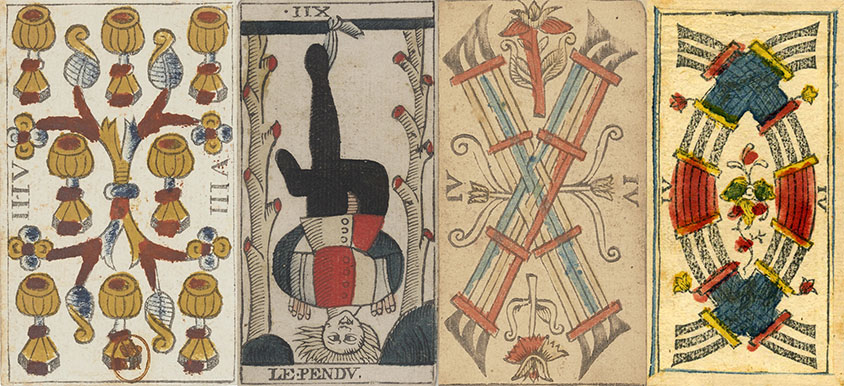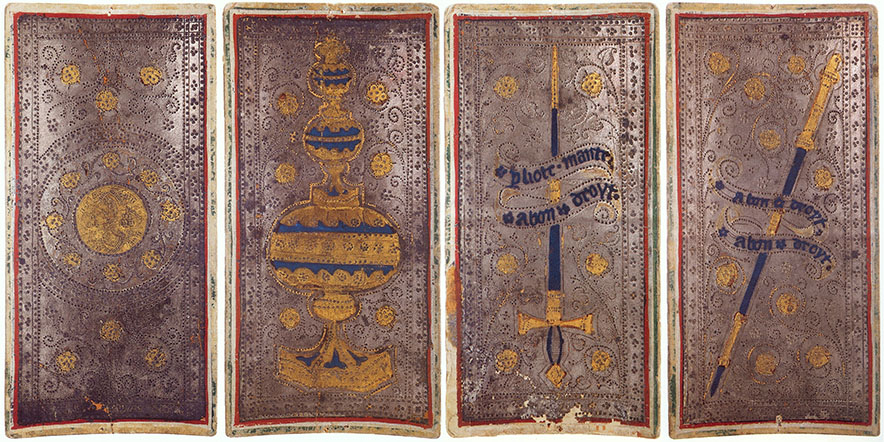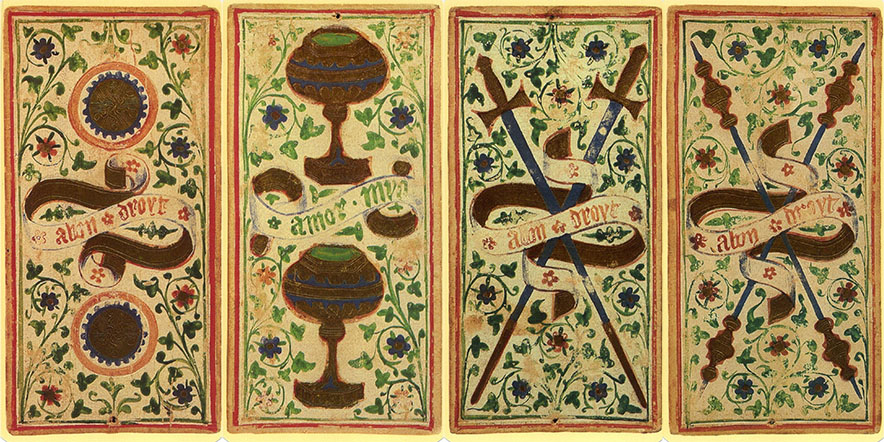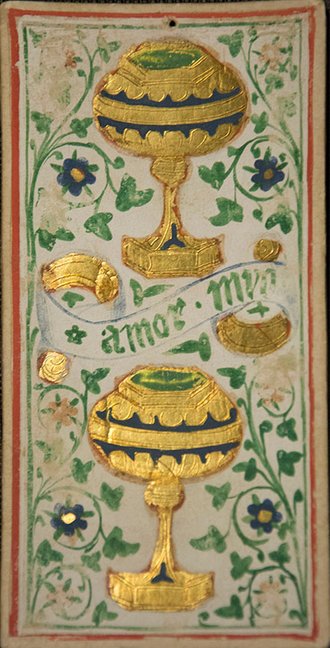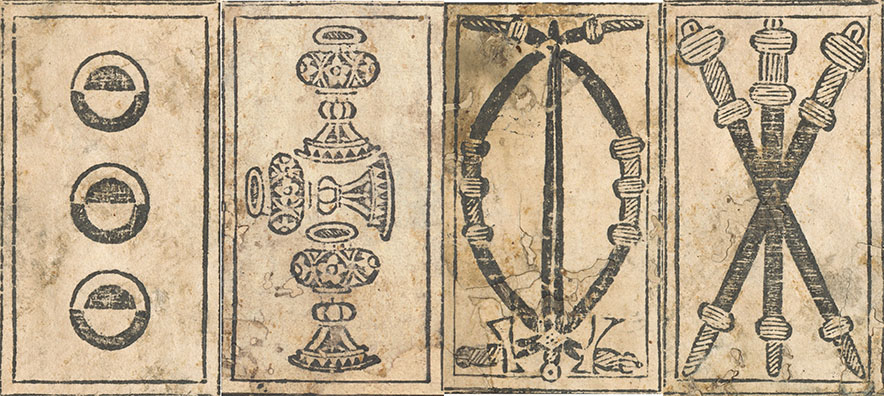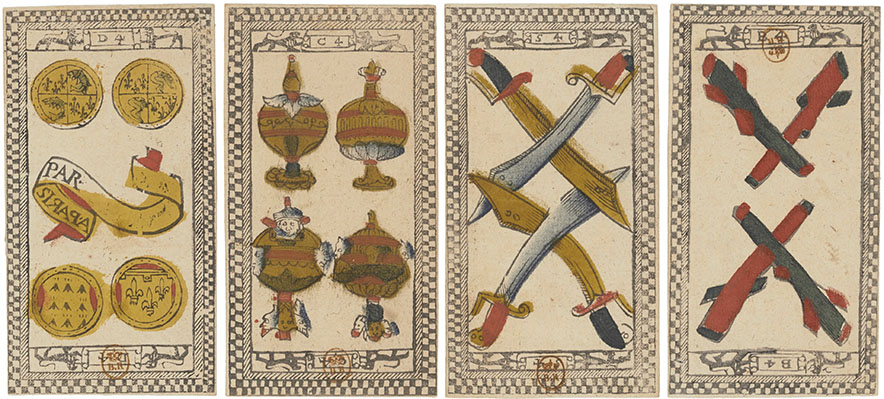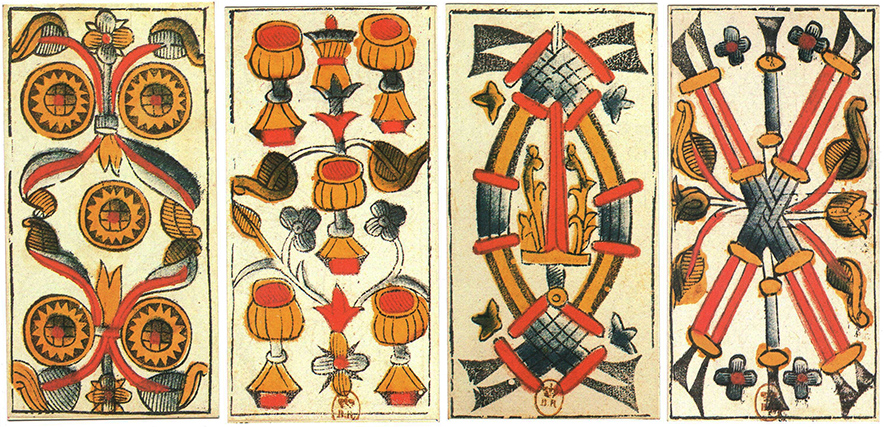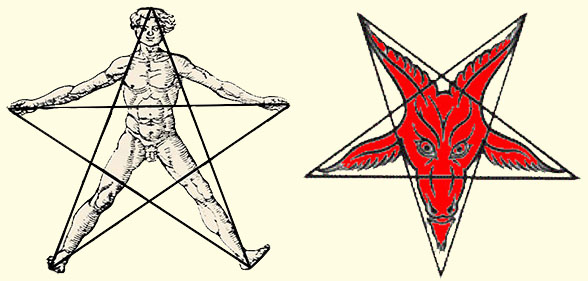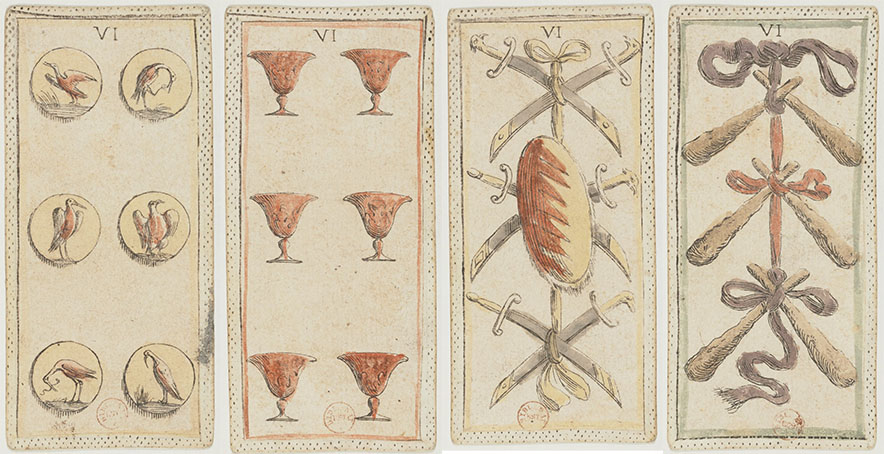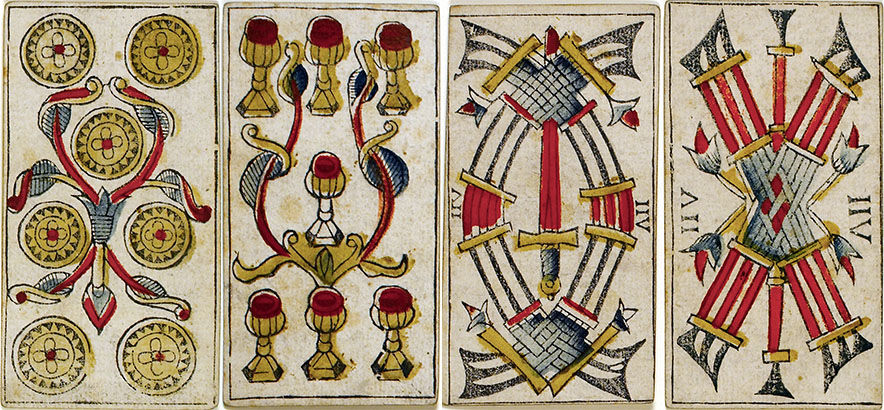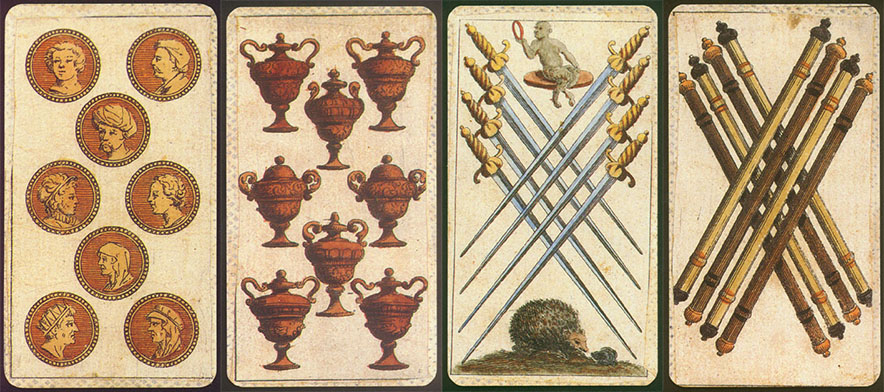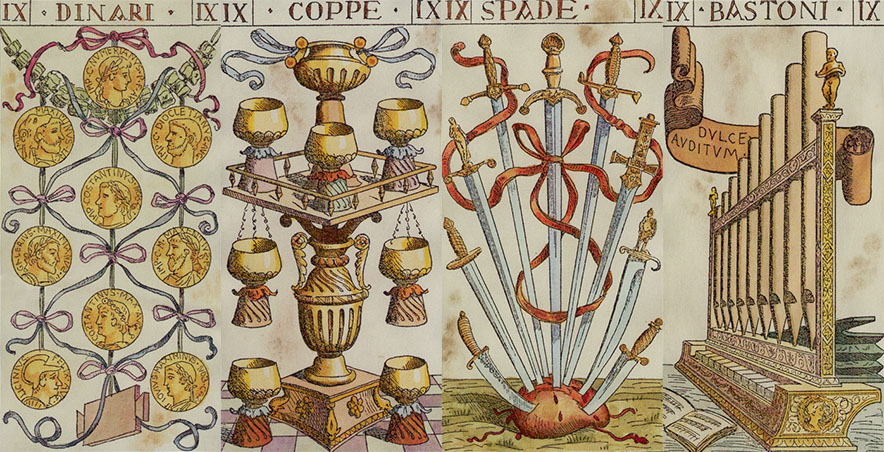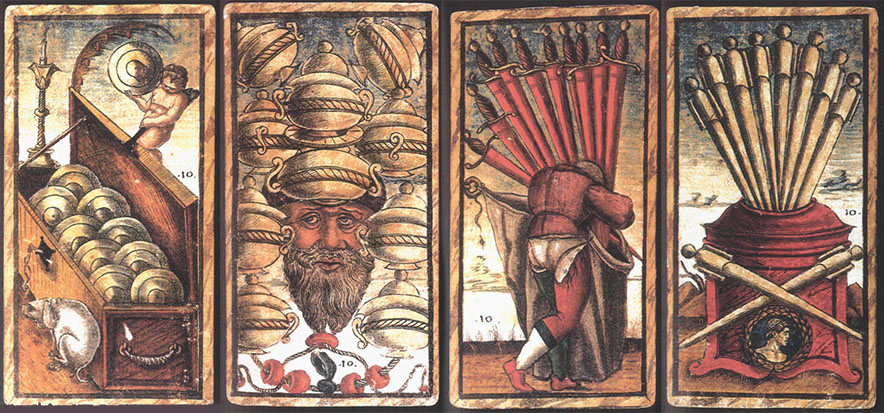THE TAROT WHEEL
THE NUMBERED CARDS
We finish with the numbered cards, the only cards where the number is important. And in such a degree, that we will have to look at the numbers in detail. Let us first clarify the distinction between number and numeral system:
Number: A number expresses the quantity of something. They can be what we call prime numbers or composed numbers. A prime number is a number greater than 1 that can only be divided by 1 and by itself. Composed numbers can be divided by other numbers, still giving a regular number as a result. Examples:
7 can only be divided by 1 and 7, so it is a prime number
10 can be divided by 1 and 10, but also by 2 and by 5, so it is a composed number
Numeral system: A numeral system defines the way a number is written. There are many numeral systems, two of them are in use on Tarot cards:
The western world is using the decimal system, a numeral system with as base 10, using the numeric characters from 0 to 9 to express any number.
Another decimal system is the Roman numeral system, a system using Roman capitals to express numbers (I = 1, V = 5, X = 10, L = 50, C = 100, D = 500 and M = 1000). The Roman numerals are only useful for small numbers. There are two systems, both used sine the classic times :
Subtractive Roman numerals:
I, II, III, IV, V, VI, VII, VIII, IX, X, XI, XII, XIII, XIV, XV, etc
Additive Roman numerals:
I, II, III, IIII, V, VI, VII, VIII, VIIII, X, XI, XII, XIII, XIIII, XV, etc.
On the Tarot, when starting writing numbers, often the subtractive Roman numeral system was used. Because woodblocks were engraved in mirror, and the people who were actually graving these blocks were frequently not literate, it was easy to make mistakes and grave IV (4) when there should be a VI (6). For this reason, the subtractive Roman numerals were rapidly replaced with additive Roman numerals, where for example both IV and VI express the number 6. Some examples of inverted numbers, here below.
From left to right the 8 of Cups from the 1659 Jean Noblet Tarot deck, the Hanged Man from the 1713 Jean-Pierre Payen Tarot deck, the 6 of Batons from the 1746 François Laudier Tarot deck and finally the 6 of Swords of an 18th Century Italian Tarocco deck made in Gorizza by an unknown artist. The number XII on the card from the Jean-Pierre Payen deck was probably not an error but intentionally inverted to emphasize the upside-down position of the hanged man. Most decks in the first half of the 18th Century used IIX instead of XII on the card representing the Hanged Man.
In the Tarot numerology, a number is not composed of an addition of 1’s, but it is considered as a multiplication of prime numbers. The smaller a number, the greater is its importance. By consequence, the number 1 is the most important number and the number 2 is more important than the number 3. The number 1 is called an Ace and has a special place in a card game. The importance of the number 2 cannot be neglected, even numbers (all numbers that can be divided by 2) are considered receptive numbers with female characteristics and uneven numbers are dynamic with male characteristics. Remark that except for the number 2, all prime numbers, the basic components of all composed numbers, are uneven.
The ten numbers that form the pip cards are composed of the Ace, four prime numbers (2, 3, 5 and 7) and five composed numbers (4, 6, 8, 9 and 10). Let us have a look at each of these numbers.
ONE
The cards here above come from the Brera Brambilla Visconti deck, commissioned by Filippo Maria Visconti, probably short before he died in 1447. We see here, of every suit, the card representing the number one. The background illustrations are only for decorative purposes. The images are copied from a book published by the Pinacoteca di Brera, the Milanese museum where the cards are conserved. Sadly enough, the cards are not on exposition, they can only be viewed on special request.
The number One can be represented by a point without dimensions. It is in potential the most powerful of all numbers. All other numbers can be constructed by adding sufficient 1’s to each other. One is the seed that can grow out to a tree, tens of meters high. One is the human cell, containing everything that defines the grown up person. Furthermore, one is the promise of a great future where everything is possible. The Ace of a specific suit has all the characteristics of that suit. Keywords for the number One are Promise, Potential, Character, Origin, Seed and Unity, but also Dictatorship and Loneliness.
TWO
As an example of the number Two, we show here the suit cards numbered two of the Visconti Sforza deck, a deck created in the first years (somewhere between 1451 and 1454) that Francesco Sforza was Duke of Milan. The images are copies of the reproduction by US Games System. In their reproduction, the original shining golden suit symbols come up in some dull brown color. I had the chance to see the 26 cards conserved in the Accademia Carrara in Bergamo, close to Milan, and the comparison is at least astonishing. The original cards are gorgeous. Here at right the Two of Cups as photographed by me in ambient light (very dark, just a bit of side lightning), flash was not allowed. The image is far from perfect, but at least it shows clearly the golden reflectance, very characteristic for these cards. I had never imagined they could be so beautiful.
The number Two can be represented by a line segment, two points connected by a straight line. With the line, we enter the first dimension. Two is the first prime number and the first even number. All even numbers can be divided by two, and all even numbers inherited the balanced female characteristics of the number Two. The number two symbolizes a bond. We have two entities, there is a choice. There is good and bad, black and white, sweet and bitter. Keywords for the number two are choice, bond, friendship, polarity, duality, balance, symmetry, complementarity but also dependence, disagreement, enemies and opposites.
On the Two of Cups shown here, we see the number two (bond, friendship, balance), combined with the suit of Cups (You, emotions). On the banner is written “amor myo”, that means “my love”. For me, it is clear that the images on the hand painted Trionfi cards were not only beautiful images made to please the Duke or the Duchess, the deeper symbolism of all the cards was definitely known to the artists and to the nobility at the Italian courts of that epoch.
THREE
For illustrating the number Three, I have chosen to show the Rosenwald sheet, dated to around 1500, the oldest uncut sheets of cards that is almost complete. It is a perfect example of how all cards should be, on every card three suit symbols and nothing more. No disturbing decoration, the cards are limited to the strict minimum. The beauty is here in the simplicity.
When we have three points that are not aligned, they define a triangle that is part of a plane. Three points are sufficient to define the second dimension, and the triangle is the geometric figure representing the number three. The number three is the second prime number ruling the series of numbers 3, 6, 9, 12 etc. The number Three is, together with the number Seven, a special number in the Tarot/ The number Three is associated with the Trinity, and the number Seven is associated with the seven days of Creation. For this reason, both numbers are associated directly with God. While the number Two is giving us a choice, three indicates that there is more than just a choice between two extremes. Between black and white there is grey, between positive and negative there is neutral. Putting a man and a woman together and a family is born. A child is coming and out of two, three has been created. This is the miracle of life and the miracle of Creation. Three is the number of creation and growth. Keywords are Trinity, life, growth, expansion, diversity, heaven and energy.
FOUR
The deck that has been chosen to illustrate the number Four is the Tarot of Paris, a deck created in the French capital Paris in the early seventeenth Century. The suit symbols are arranged on all four cards in a nice symmetrical structure. The Tarot of Paris is the first surviving Tarot where we see the number on the cards, both on the top and the bottom. The character indicates the suit and the number, the number of the card. Interesting is that we see here standard numerals compared to the Roman numerals on later decks. The deck has been inspired by earlier Italian decks. For the Swords (Epées in French) we see the as a first character the letter S, like the Italian Spade. On the court cards we see an F (Fante in Italian) on the cards depicting a Page. In the French language, this should be a V (Valet).
The number Four is the first composed number; it is created by multiplying two times two. If these two line segments stay parallel, they form a square in two dimensions. If on the contrary the two line segments are perpendicularly and not crossing each other, they form a three-dimensional structure, a tetrahedron, the most stable of all structures. An example of this structure in nature is the Diamond, the hardest of all materials. So as a tetrahedron, the number 4 defines the third dimension, it gives body to things. In two dimensions, the number Four is represented by a square. With the double bond of two times two, the number four stands for order and stability. We find the number Four in many things, to start with the four suits of the Tarot, the four cardinal points, the four evangelists, the four elements and the four seasons. The number Four helps us to organize our life. Keywords for the number four are Order, Organization, Structure and Stability.
FIVE
The number Five is illustrated by the Tarot of Jaques Vievil, produced like the previous deck in Paris, in the mid of the seventeenth Century. We are reaching the summit of the French Monarchy. Louis XIV became King of France in 1643 at the age of 4 years, and he would stay King for over 72 years. His successor, his great-grandson Louis XV, became like him King at a very early age, 5 years, and would keep the royal crown for 59 years. The abundant floral decorations on the cards are typical for the spirit of the time.
In geometry, a fifth point does not add a dimension, our world is three-dimensional. What it is adding is time, and with time, things will change. In three dimensions, the number five is represented by the mysterious pyramid, and in two dimensions, by a pentagram. The number Five is after the numbers two and three, the third prime number. We are leaving the order and stability of the number four to go into an uncertain area. Five is often called the number of Magic. A pentagram pointing upwards can be compared with the human body and White Magic. When the same pentagram is pointing downwards, it symbolizes the head of Satan and Black Magic. The fifth element is linked to the journey of the Human Soul, it brings us to unknown territory. The keywords for the number Five are change, magic, travel and uncertainty.
SIX
To illustrate the number Six, I’ve chosen the Tarocchini di Giuseppe Mitelli, created between 1660 and 1670 in Bologne. The deck has only 62 cards, the numbered cards from 2 to 5 do not appear in this deck. The suit symbols are arranged in an identical way on all four cards, three pairs of suit symbols, clearly showing that the number six consists of three pairs. For the first time we see the number in Roman numerals, a VI written on the upper part of all cards.
In two dimensions, we can illustrate the number Six as two inverted triangles, a hexagram, also called the Star of David. In three dimensions, we represent the number six with three perpendicular lines, forming the three axes of our three-dimensional world. The number six is the second composed number; it is composed by the multiplication of two and three, like a growing bond. The growing bond stands for prosperity and harmony. God created the World in 6 days; it was on this sixth day he created man and woman in the image of himself. For this reason, six is also man’s number. Keywords for the number Six are harmony, prosperity, good luck, beauty and health.
SEVEN
The number Seven is introduced by the Tarot of Jean Dodal, realized around 1701 in Dijon. The cards are typical for the Tarot of Marseille. What is interesting is that the Coins and Cups don’t have a written number. The Swords and Batons have a number both on the left and on the right side of the card. And on both sides of both cards, the seven is misspelled as IIV. This confirms what we have seen above, the reason why the additive Roman numeral system was used, mistakes were easily made.
The number Seven cannot easily be captured in one representative figure in two or three dimensions. In fact, several regular figures can be formed that have seven points. Seven is the fourth prime number. God created the World in six days and rested on the seventh day. That is why seven is the number of God, and that is also why the week has seven days. Muslim (Friday), Jews (Saturday) and Christians (Sunday), all have in common a week of seven days, where the last day is dedicated to God himself. In ancient times people could see seven moving bodies in the sky, Sun, Moon, Mercury, Venus, Mars, Jupiter and Saturn. This is why there were seven levels of Heaven and seven levels of Hell. All music can be described using seven notes. Like the number Three, the number Seven is an exceptional number in the Tarot. The Tarot Wheel is made originally out of three groups of seven cards, to be changed in the Tarot of Marseille in seven groups of three cards, both figures with a card representing God and the Universe in the Axis. The keywords for the number Seven are completeness, rest, safety, security and spiritual wisdom.
EIGHT
The number eight is introduced here by the Minchate Etruria. This deck has 97 cards; there are 21 supplementary trump cards. With the evolution of the printing techniques, we can see that the cards become more and more sophisticated.
In three dimensions, the number Eight stands for a cube, a perfect geometrical body formed by eight interconnected points. Eight is a composed number, created out of only two’s, two times two times two, or if you want two times four. Bonds multiplied by stability give perfection and the ultimate structure. The number Eight represents one of the most stable and balanced structures there exist, the cube. But perfection has also its lesser sides, it can be a little dull, lacking the unknown that makes life so interesting. The keywords of the number Eight are perfection, abundance, ultimate structure and infinity, but it can also indicate boredom.
NINE
The number Nine is symbolized by the Tarot deck created in 1893 by Vachetta. The way of exposing the suit symbols has nothing to do with earlier Tarot decks. Every single card is a heavily illustrated piece of art. Apart from the suit symbols, there is a lot of decoration, making the cards overcharged.
The best geographic figure representing the number nine consists of three interlacing triangles. The number Nine is the fourth composed number, three times three. This growth multiplied with itself gives a super growth, and leads to overabundance. With the number eight, we were at the summit of perfection, now we are moving away. It is time to collect the fruits of work that has been done, otherwise they will rot away. Keywords for the number Nine are fulfilment, interest and harvest but also overabundance, rotting away, uncontrolled growth (Cancer), waste and deterioration.
TEN
To introduce the last number, the number Ten, we go back in time again. Ten is the end of a cycle and a new start. For this reason, we show here the Ten’s of the Sola Busca deck, made in northern Italy in 1491. It was a deck many years ahead of its time, and all cards were illustrated. It was maybe the first esoteric card deck, specially made for this purpose.
The number ten is best represented by the marriage of two pentagrams, one pointing upwards and the other pointing downwards. Ten is a composed number, two times five. With these two pentagrams, black magic and white magic are united in one. The cycle is completed and rebirth is there. All different numerals are present in the series from 1 to 9, with the number 10 we are back again in 1, the seed that contains everything. This totality of everything is symbolized by the Ten Commandments that contains all the laws that God needed for us. The number Ten can signify that the cycle has been completed or in contrary that it has failed and that we have to restart from the beginning. The number Ten corresponds to going back to start, restarting the cycle. Keywords for the number Ten are cycle, finish, rebirth, reincarnation, starting over, back to unity.
